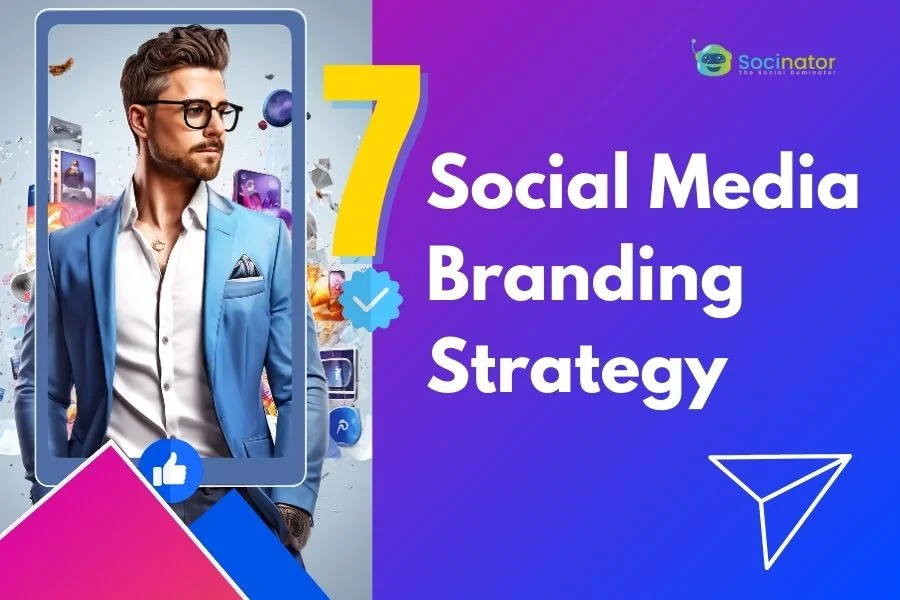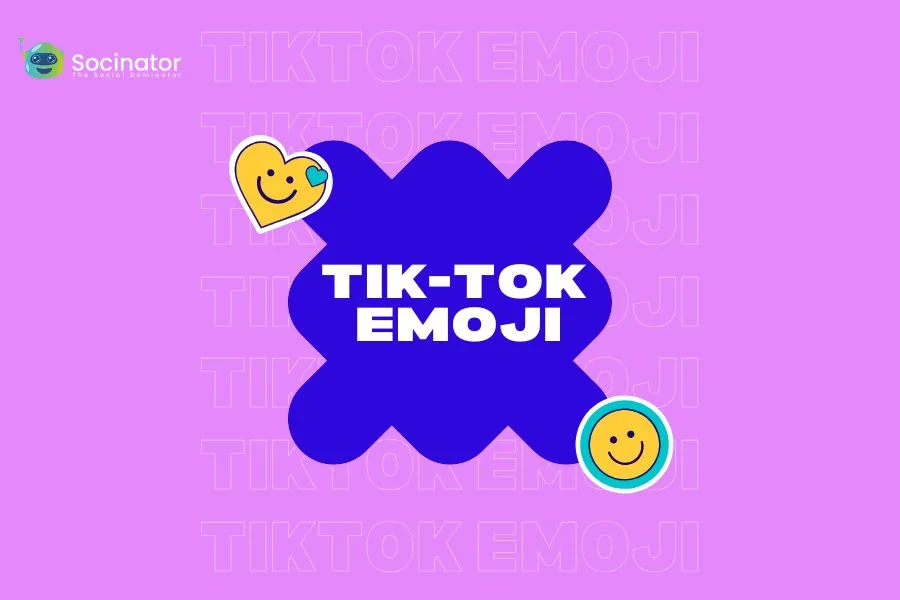Don’t you want to promote your brand on social media? Well, every marketer does. And we have got you covered.
Even though you’ve got a fantastic product or service, you need more exposure for your brand to sell. That’s why- in today’s scenario, branding is a must for any business.
In this social media era, where attention spans are shorter than ever, having good branding on social media gives you an edge. Creating a brand for yourself that cuts through the noise and makes your business stand out needs a perfect branding strategy.
Fear not, fellow entrepreneur! This blog dives headfirst into the top social media branding strategies for 2024. We’ll explore the latest trends, the platforms to prioritize, and the secrets to building a loyal following for your brand.
So, grab your phone, fire up your laptop, and get ready to transform your social media presence!
Listen To The Podcast Now!
What Is Social Media branding Strategy
A social media branding strategy is a comprehensive plan designed to establish and promote a brand’s identity, values, and messaging on social media platforms. This strategy encompasses various tactics and activities aimed at creating a cohesive and recognizable presence that resonates with the target audience, fosters engagement, and drives business goals.
Now we know what is social media branding strategy, let us understand why social media branding is crucial.
Why Social Media Branding Is Crucial
With millions of users, Social media has become a crowded market with unlimited opportunities and plenty of challenges. With such a large no of users, you can reach and connect with potential customers and build lasting relationships. But with countless brands vying for attention, you need a clear branding strategy to shine.
Social media branding is a popular way to promote your brands by reaching your audience and knowing why it is crucial –
Cut Through the Noise:
In this crowded marketplace, standing out is a significant challenge, and social media branding provides a vital solution. It helps differentiate your brand by creating a unique and consistent presence across platforms, making your brand memorable and distinct from competitors. This involves developing a clear brand voice, visual identity, and messaging that resonates with your target audience. Furthermore, creative and engaging content is key to attracting attention and gaining popularity.
Humanize Your Brand:
Social media allows you to connect with people on a personal level. It helps showcase your brand’s values and build trust. Here are the branding strategies to humanize your brand on social media :
Share Behind-the-Scenes Content:
- Provide a glimpse into your company culture.
- Showcase the people who make your business run.
- Highlight Employee Stories:
- Highlight your employees’ personal stories and accomplishments.
- Feature employee spotlights and interviews.
Post-Customer Testimonials:
- Share real-life experiences and reviews from customers.
- Highlight user-generated content and success stories.
- Engage Directly with Your Audience:
- Respond to comments, messages, and mentions promptly.
- Participate in conversations and address customer inquiries.
Boost Brand Loyalty:
Boosting brand loyalty involves cultivating a strong commitment among customers towards your brand. Building a community around your brand is a powerful method to achieve this. It includes creating a space where customers feel connected to your brand and facilitating interactions and engagement. Implement this branding strategy to boost brand loyalty:
Create a Branded Community Platform:
- Establish an online platform such as a forum, social media group, or dedicated website section where customers can connect with your brand.
Encourage User-Generated Content (UGC):
- Promote customers to share their experiences, stories, and photos related to your brand or products on social media platforms using branded hashtags. This way you can encourage user-generated content.
- Reward Customer Engagement:
Recognize and reward loyal customers for their engagement and advocacy through loyalty programs, exclusive offers, or personalized discounts.
Personalized Marketing:
- Utilize data analytics and insights to understand your audience’s preferences and behavior.
- Tailor your marketing messages and offers to suit individual customer needs and interests.
Exclusive Offers and Rewards:
- Offer special discounts, promotions, or rewards to your social media followers.
- Create exclusive access to new products, services, or events for loyal customers.
Customer Service Excellence:
- Provide prompt and helpful responses to customer inquiries and complaints on social media.
- Resolve issues transparently and professionally to build trust and loyalty.
Drive Sales & Growth:
Social media is a powerful tool to aid you in your brand marketing strategy. You can use this branding strategy to nurture leads and convert them into loyal customers :
Lead Nurturing:
- Identify potential leads through social media interactions, website visits, and engagement with your content.
- Deliver relevant, personalized content tailored to each stage of the buyer’s journey.
- Use targeted advertising and retargeting campaigns to keep your brand top-of-mind and encourage conversions.
Conversion Optimization:
- Direct followers to your website or landing pages with compelling calls-to-action (CTAs) in your social media posts.
- Offer exclusive promotions, discounts, or incentives to incentivize purchases.
- Leverage social proof by showcasing customer testimonials, reviews, and case studies to gain trust and build credibility.
Performance Tracking and Optimization:
- Use social media analytics tools to track key performance metrics such as engagement, click-through rates, and conversions.
- Analyze the effectiveness of your content and campaigns and make data-driven adjustments to optimize results.
- Continuously test different strategies, messaging, and offers to identify what resonates best with your audience and drives sales and growth.
Now, let us delve into the crux of the blog and learn about social media branding strategy.
Also Read
How To Stand Out In Crowd: Personal Branding Social Media?
How To Make Branding Effective With UGC Content Creation
Pinterest Branding Ideas: Create Brand For Your Business
The Top Social Media Branding Strategy for 2024
Now that we’ve established the “why,” let’s dive into the “how.” Here are the top social media branding strategies you need to master in 2024:
1. Research your audience
Before you start posting, take a step back. Learn and research about the consumers whom you are trying to reach and sell. To craft a successful social media marketing strategy, you must delve into the interests, challenges, and online habits of the target audience. In this branding strategy, understanding these aspects forms the cornerstone of effective engagement and resonance with your audience.
Here are some branding strategy tips for the audience research:
Create buyer personas: Develop detailed profiles of your ideal customer, including demographics, interests, and online habits.
Social media listening: Social media listening helps you understand how users perceive your brand and industry trends.
Engage and respond: Ask questions, answer comments, and participate in relevant conversations. It fosters a connection with your audience and provides valuable insights into their preferences.
2. Choose the Right Platforms
With the abundance of social media platforms, it’s tempting to try to be active on all of them simultaneously. For this branding strategy, it’s better to focus on a few key platforms where your target audience spends their time.
Here’s a quick rundown of the major platforms and their strengths:
Facebook:
With its extensive user base spanning various demographics, Facebook remains a cornerstone of social media marketing. It allows businesses to create pages, share content, run targeted ads, and engage with followers through comments, messages, and live videos. Its robust analytics tools enable businesses to track performance and refine their strategies accordingly.
Instagram :
Instagram, renowned for its captivating visuals, offers an ideal platform for businesses aiming to exhibit their products, services, and brand identity via top-notch images and videos. Features like Stories, IGTV, and Reels offer diverse content formats to engage followers. Influencer partnerships and hashtags also play crucial roles in amplifying reach and engagement.
YouTube:
As the second-largest search engine globally, YouTube is indispensable for businesses aiming to leverage video content. It allows for longer-form content like tutorials, product demonstrations, and behind-the-scenes glimpses, fostering deeper engagement with audiences. YouTube videos can boost brand visibility and authority through effective SEO optimization and cross-promotion strategies.
LinkedIn:
Geared towards professionals and B2B networking, LinkedIn branding provides a platform for businesses to showcase expertise, thought leadership, and company culture. Features like Company Pages, LinkedIn Articles, and LinkedIn Live enable businesses to connect with industry peers, attract talent, and generate leads through targeted content and networking efforts.
Twitter:
With its real-time nature and concise messaging format, Twitter excels in rapid communication, news sharing, and customer engagement. Businesses can leverage Twitter for timely updates, promotions, customer service, and industry insights, fostering conversations with followers and enhancing brand authenticity and relevance.
Once you’ve identified your ideal platforms, research their algorithms to understand how content is ranked and displayed.
3. Content Is King For Branding Strategy
Now comes the most fascinating part of the blog: creating content that resonates with your audience. Social media is all about valuable, engaging, and entertaining content.
Here are some tips for creating winning social media content in 2024:
Authenticity Is The Key:
People connect with genuine brands. Showcase your brand personality through your voice and visuals. Here is how you can build authenticity with this branding strategy:
- Transparency: Admitting mistakes and showing how you learn from them can foster a deeper connection with your audience.
- Voice and Tone: Develop a consistent and relatable brand voice that reflects your company’s personality. Whether it’s witty, professional, or friendly, it should feel real and not forced.
Variety Of Content Format:
Mix up your content formats with images, videos, stories, live sessions, and informative blog posts. Use this branding strategy by incorporating these content formats –
- Images: Use high-quality photos and graphics for attention-grabbing announcements, quotes, and product showcases.
- Videos: Videos are engaging and versatile for tutorials, product demos, behind-the-scenes looks, or customer testimonials.
- Stories: Instagram and Facebook Stories are perfect for sharing quick updates, promoting events, and showcasing time-sensitive content.
- Blog Posts: Share in-depth articles and blog posts that provide value to your audience.Storytelling power: People love to hear stories! Create captivating and emotionally appealing narratives that resonate and connect with your audience.
Brand Story:
Share your brand’s origin, mission, and journey. People are interested in understanding the reason behind your actions.Here is how to use this branding strategy:
- Customer Stories: Highlight stories from your customers about how your product or service has impacted their lives.
- Employee Stories: Feature stories from your employees about their roles, experiences, and what they love about working with your company.
- Campaign Narratives: Use stories to highlight these themes and show how your brand is aligned with their values.
- Interactive Stories: Use interactive content, such as polls, quizzes, and interactive videos, to create engaging and participatory narratives.
Create High-Quality Visuals
High-quality visuals are more likely to capture attention and convey professionalism. They make your content more attractive and engaging.
Tips for High-Quality Visuals:
- Professional Photography: Invest in good photography or use high-quality stock images that align with your brand.
- Consistent Branding: Use consistent colors, fonts, and styles that reflect your brand’s identity.
- Graphics and Infographics: Create custom graphics and infographics to visually communicate complex information or data.
4. Community building
It is a powerful aspect of branding strategy that focuses on creating and nurturing a loyal and engaged community around your brand. Here’s how you can build community with this branding strategy:
Facilitate Communication: Provide multiple channels for your audience to engage with each other and with your brand. It could include social media platforms, online forums, live chats, or dedicated community groups. Be responsive to comments, messages, and feedback to foster a sense of connection and dialogue.
Encourage Participation: Actively encourage your audience to participate in discussions, share their experiences, and contribute their content. It could involve running contests, challenges, or themed campaigns encouraging user involvement.
Listen and Adapt: Take care of the community’s needs, preferences, and feedback. Use insights from interactions and discussions to adapt your content, messaging, and initiatives for a clear picture of your audience.
Host Events and Meetups: This involves arranging gatherings, whether online or in person, such as webinars, workshops, meetups, or product launches. These events provide opportunities for members of your community to connect, interact, and build relationships with each other while also engaging with your brand in a more meaningful way.
5. Influencer Partnerships
Partnering with influencers is a powerful way to expand your brand’s reach and enhance its credibility. Select influencers whose values align with your brand and whose audience reflects your target demographic. Ensure that partnerships feel authentic and provide value to both the influencer and your brand. So, here are some tips for executing a successful branding strategy:
Align with Your Brand Values: Choose influencers whose values align with your brand’s mission, vision, and values. It ensures the partnership feels authentic and resonates with the influencer’s audience and your target demographic.
Encourage Authenticity: Encourage influencers to create content that feels authentic and genuine to their audience while incorporating your brand message or product. Authenticity is the key to building trust and credibility with their audience and ensuring a successful partnership.
Build Long-Term Relationships: Invest in long-term relationships with influencers who align well with your brand and consistently deliver results. Nurture these relationships by providing ongoing support, collaboration opportunities, and mutual value in exchange for fostering loyalty and advocacy.
6. Monitor and Analyze Performance For Branding Strategy
Regularly track key performance metrics such as engagement, reach, impressions, and conversions to evaluate the effectiveness of your social media efforts. Use analytics tools to gain insights into your audience’s preferences and behavior and adjust your branding strategy accordingly.
Tracking and assessing performance is vital in fine-tuning your brand’s social media strategy for optimal results. Here are some tips on how to effectively monitor and analyze performance:
Identify Key Metrics: Determine which metrics are most relevant to your brand objectives. Such metrics include engagement (likes, comments, shares), reach (number of people who see your content), impressions (number of times your content is displayed), and conversions (actions taken by users such as website visits, purchases, or sign-ups).
Set Benchmarks: Establish benchmarks or goals for each metric based on past performance, industry standards, or your desired outcomes. It will help you track progress over time and measure the success of your efforts and branding strategy.
Utilize Analytics Tools: Make the most of social media analytics tools offered by platforms such as Facebook Insights, Twitter Analytics, and Instagram Insights.
Measure ROI: Compare the costs of your social media campaigns to outcomes like website traffic, leads, or revenue to assess effectiveness and profitability.
7. Adopt Automation Tool
Adopt automation tools for your brand strategy to streamline processes, save time, and improve efficiency. These tools can help with scheduling posts, responding to messages, analyzing data, and more, allowing you to focus on strategy and creativity.
If you are seeking an automation tool for your social media branding strategy then you are at the right place, then We have something for you.
Socinator – A Complete Social Media Automation Solution
Socinator isn’t just another social media marketing software—it’s the ultimate solution for brands. Its intuitive interface and advanced automation features simplify your social media tasks and help you craft an effective branding strategy. Socinator Unique provides an all-in-one solution for your brand strategy and streamlines your posting. Let’s delve into a few of its more sophisticated functionalities –
Access 8 social media platforms – Socinator provides access to 8 major social media platforms, including Facebook, Instagram, YouTube, Reddit, Pinterest, Tumblr, Quora, and Twitter, all within one convenient platform. It allows brands to streamline their social media management efforts by centralizing their activities across multiple channels.
Scheduling and collaborating – With Socinator, brands can plan, collaborate, and schedule their social media video content ahead of time. This feature enables efficient content planning and ensures a consistent presence on platforms.
Track insights – It also offers insightful analytics tools that allow brands to track and analyze their social media performance. By monitoring key metrics such as engagement, reach, impressions, and conversions, brands can gain valuable insights into the effectiveness of their social media branding strategy and make data-driven decisions to optimize their performance.
Content calendar – The platform includes a content calendar that helps brands stay organized and on track with their social media posting schedule. By visualizing upcoming posts and campaigns, brands can ensure timely and consistent content for their audience.
Conclusion
Building a personal brand is not so challenging but requires a strong branding strategy. We’ve covered everything from the importance of social media branding to the top strategies you need to master to build a personal brand. Whether you’re looking to research your audience, choose the right platforms, create engaging content, build a loyal community, collaborate with influencers, or analyze performance to build a personal branding strategy, we’ve got you covered.
And if you’re seeking an automation tool to streamline your branding strategy, look no further than Senator. With its intuitive interface, advanced features, and access to 8 major social media platforms, Socinator is the ultimate solution for brands looking to automate their social media tasks and elevate their presence online.











